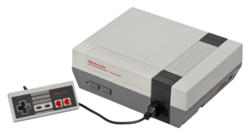
Back NES AN نينتندو إنترتينمنت سيستم Arabic نينتيندو انترتينيمنت سيستم ARZ Nintendo Entertainment System AST Nintendo Entertainment System Byelorussian Nintendo Entertainment System Breton Nintendo Entertainment System BS Nintendo Entertainment System Catalan سیستمی چێژبەخشی نینتێندۆ CKB Nintendo Entertainment System Czech
 | |
Top: NES Control Deck with detachable controller Bottom: Family Computer ("Famicom") main unit with hardwired controllers | |
| Also known as | |
|---|---|
| Developer | Nintendo R&D2 |
| Manufacturer | Nintendo |
| Type | Home video game console |
| Generation | Third |
| Release date | |
| Introductory price | ¥14,800 (equivalent to ¥18,365 in 2019) US$180 (equivalent to $530 in 2024)[5] |
| Discontinued | |
| Units sold | 61.91 million[8] |
| Media | Nintendo Entertainment System Game Pak |
| CPU |
|
| Memory | 2 KB work RAM 2 KB video RAM 256 bytes sprite RAM |
| Display | 256 × 240 px |
| Graphics | PPU (Ricoh 2C02) |
| Sound | APU, 5 channels: 2 pulse wave, triangle wave, white noise, DPCM |
| Controller input | 2 controller ports[d] 1 expansion slot |
| Best-selling game |
|
| Predecessor | Color TV-Game |
| Successor | Super Nintendo Entertainment System |
| Related | Famicom Disk System Famicom 3D System |
The Nintendo Entertainment System (NES) is an 8-bit home video game console developed and marketed by Nintendo. It was first released in Japan on 15 July 1983 as the Family Computer (Famicom, abbreviated FC),[note 1] and was later released as the redesigned NES in several test markets in the United States beginning on 18 October 1985, followed by a nationwide launch on 27 September 1986. The NES was distributed in Europe, Australia, and parts of Asia throughout the 1980s under various names. As a third-generation console, it mainly competed with Sega's Master System.
Nintendo president Hiroshi Yamauchi called for a simple, cheap console that could run arcade games on cartridges. The Famicom was designed by lead architect Masayuki Uemura, with its controller design reused from Nintendo's portable Game & Watch hardware. The western model was redesigned by Nintendo of America designers Lance Barr and Don James to resemble a video cassette recorder. Nintendo released add-ons such as the NES Zapper, a light gun for shooting games, and R.O.B, a toy robot.
The NES is widely regarded as one of the most influential gaming consoles of all time. It helped revitalize the North American gaming industry following the video game crash of 1983, and pioneered a now-standard business model of licensing third-party developers to produce and distribute games.[11] Several games released for the NES, including Super Mario Bros. (1985), The Legend of Zelda (1986), Metroid (1986), and Mega Man (1987), went on to become landmark franchises.
While the console dominated Japanese and North American markets, it did not perform as well in Europe,[e] where it faced strong competition from the Master System and the ZX Spectrum. With 61.91 million units sold, it remains the 14th best-selling console of all time. Nintendo ceased production of the NES in 1995, and the Japanese Famicom in 2003. It was succeeded in 1990 by the Super Nintendo Entertainment System.
- ^ Kohler, Chris (18 October 2010). "Oct. 18, 1985: Nintendo Entertainment System Launches". WIRED. Archived from the original on 26 November 2020. Retrieved 11 June 2015.
- ^ Top Hat Gaming Man (28 April 2019). Hyundai Super Comboy – The Story of The Super Nintendo Console in South Korea!. Event occurs at 7:48. Archived from the original on 26 June 2023 – via YouTube. [unreliable source]
- ^ "La NES cumple 40 años: La historia de la icónica consola ochentera de Nintendo que revolucionó al mundo" [The NES Turns 40: The Story of Nintendo's Iconic 80s Console That Revolutionized the World]. The Clinic (in Spanish). 14 July 2023. Retrieved 14 February 2025.
A Chile llegó apenas el año 1991.
[It didn't reach Chile until 1991.] - ^ "Video Games Around the World: South Africa". Archived from the original on 25 September 2022. Retrieved 25 September 2022.
- ^ Levin, Martin (20 November 1985). "New components add some Zap to video games". San Bernardino County Sun. p. A-4.
- ^ "編集者の目/企業者からのメッセージ". 任天堂株式会社. Archived from the original on 13 April 2004. Retrieved 11 January 2025.
- ^ "Nintendo Entertainment System (NES) – 1985–1995". Classic Gaming. GameSpy. Archived from the original on 29 October 2012. Retrieved 20 December 2019.
- ^ a b "Consolidated Sales Transition by Region" (PDF). Nintendo. March 2016. Archived (PDF) from the original on 27 April 2016. Retrieved 12 September 2022.
- ^ Stuart, Keith (13 September 2010). "Super Mario Bros: 25 Mario facts for the 25th anniversary". The Guardian. Archived from the original on 9 August 2017. Retrieved 2 November 2018.
- ^ "All Time Top 20 Best Selling Games". 21 May 2003. Archived from the original on 21 February 2006. Retrieved 31 January 2008.
- ^ Sanchez-Crespo, Daniel (8 September 2003). Core Techniques and Algorithms in Game Programming. New Riders Games. p. 14. ISBN 0-13-102009-9.
- ^ a b Sheff, David (1993). Game Over. New York: Random House. ISBN 0-679-40469-4. Retrieved 2 July 2019.
Cite error: There are <ref group=lower-alpha> tags or {{efn}} templates on this page, but the references will not show without a {{reflist|group=lower-alpha}} template or {{notelist}} template (see the help page).
Cite error: There are <ref group=note> tags on this page, but the references will not show without a {{reflist|group=note}} template (see the help page).
© MMXXIII Rich X Search. We shall prevail. All rights reserved. Rich X Search

